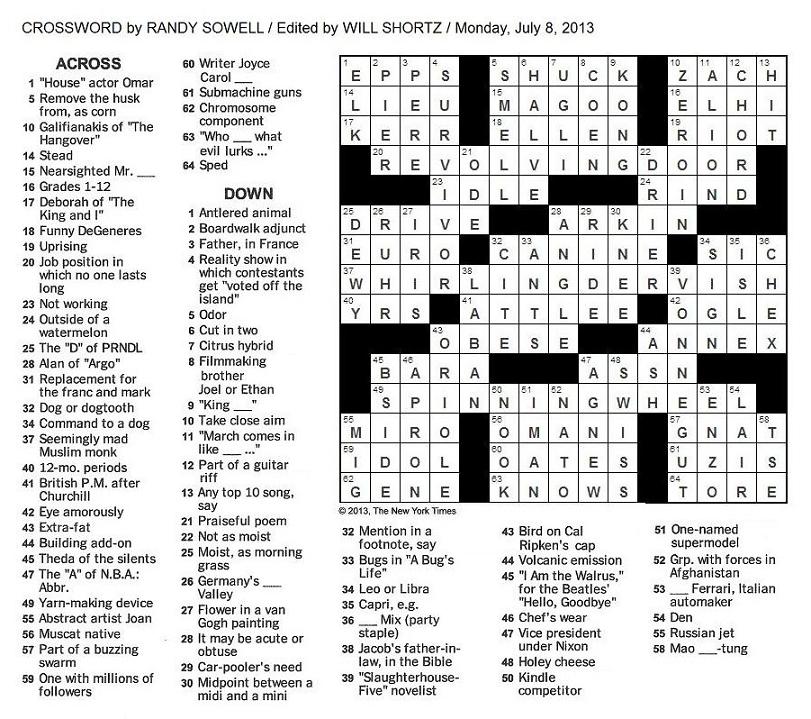

- Place crossword nytimes manual#
- Place crossword nytimes full#
- Place crossword nytimes trial#
- Place crossword nytimes mac#
Maintaining rotational symmetry can be a pain, but fortunately, CrossFire takes care of that for you. One longstanding rule is that grids must be rotationally symmetric, which means that they look the same if you turn them upside-down (other kinds of symmetry exist, too, but that’s a topic for an advanced grid-design column!). STEINBERG: Before we do that, though, let’s back up a little. When I worked as a summer intern for Will Shortz, he showed me an old crossword reference book which had pages and pages of, say, five-letter words that have the structure “?W?.” I’m definitely glad we have our robot overlords to do those sorts of searches for us now.
Place crossword nytimes manual#
There’s a case to be made that manual construction helps you learn the contours of the English language better than software does, but maybe the biggest boon is how much faster the software is. To answer your question, I use CrossFire - although I got my start with pencil, graph paper and online dictionaries.

LAST: O.K., O.K., I’ll take three orders of the software, and a Shamwow to boot. Natan, what are your thoughts on manual construction? And which software do you use? Looks very cool, although I’ll confess I haven’t played around with it much.
Place crossword nytimes full#
The biggest downside to Crossword Compiler is its price - if you want the full Professional Bundle, it will set you back $169.Ī third, brand-new option is Keiran King’s free, web-based crossword construction program, Phil. For example, Crossword Compiler has much more user-friendly environments for searching and editing word lists.

It doesn’t have as many bells and whistles as the Windows-only Crossword Compiler, though.
Place crossword nytimes mac#
If you’re on a Mac like me, I highly recommend CrossFire, which has a nice grid-filling environment and, at $50, it won’t break your budget. STEINBERG: There are a few ways to make a crossword puzzle, including the good, old-fashioned graph-paper-and-pencil method, but there are several excellent software programs that make designing and filling grids easier. STEINBERG: If only! Choosing the Right Tool NATAN LAST: Wait, practice? I thought we just plug our lovely theme answers into a piece of software and, voilà, a beautiful crossword emerges. Let’s watch them work it out.ĭAVID STEINBERG: I’d say grid design is the hardest part of the construction process to get the hang of, but we believe in all the aspiring constructors out there! All it takes is a few guiding principles and lots of practice. The goal is to place the theme entries and black squares in such a way as to get the best chance of filling the puzzle with sparkling, lively nontheme entries.
Place crossword nytimes trial#
Just as in theme development, there is a lot of trial and error. Vigeland left off to demonstrate the next step in making a crossword puzzle: setting the theme entries in a blank crossword grid and placing the black squares. Their fellow constructors, David Steinberg and Natan Last, pick up where Mr.

■ 91A: “Staff openings?” could refer to job listings, but today it refers to a musical staff, and the answer is CLEFS.DEB AMLEN: In Part 1 of “How to Make a Crossword Puzzle,” the puzzle makers Ben Tausig and Finn Vigeland developed a theme for a crossword puzzle by bouncing ideas back and forth until a cohesive set that follows the rules of constructing came together. Today, it refers to an OIL SLICK, which is filmy. ■ 79A: This “Disaster film?” was not made by Irwin Allen. ■ 43A: If you’ve DENTED something, you’ve definitely “Made an impression?” ■ 39A: There’s more than one way to be spicy, and today, “Spicy fare?” refers to EROTICA. And let’s not forget that the nontheme fill is still fairly decent. Chen has managed to place the “place” phrases very close to their base phrases. Chen’s puzzles - is that the theme is so tight, and by that I mean that 1) the adjectival words in each theme phrase are placed as close to the center of each base phrase, 2) All of the base phrases and their “places” are lively entries and 3) Mr. What’s nifty about this - I use the term “nifty” a lot when I talk about Mr. 42D is MA DE A DIFFERENCE, which is a DEAD SPOT (43D).Īnd 116A is FORENSI C ANALYST, also known as a CANAL ZONE (106A).


 0 kommentar(er)
0 kommentar(er)
